32+ Sample Artist Statement Templates
-

Artist Business Statement
-

Sample Artist Statement
-

Sample Developing Artist Statements
-

Basic Artist Statement
-
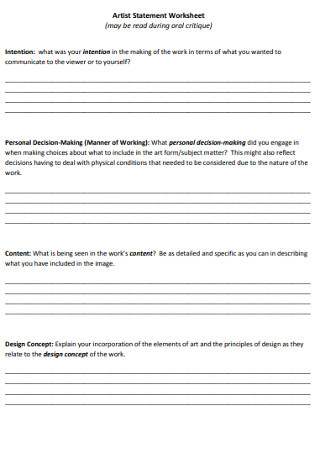
Artist Statement Worksheet
-
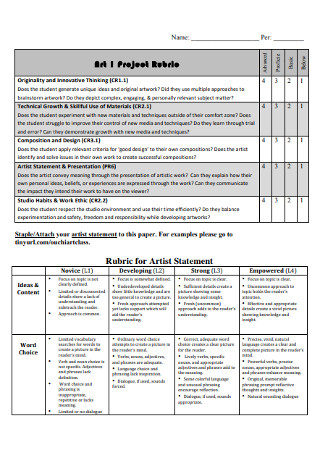
Artist Project Statement
-

Human Condition Collection Artist Statement
-
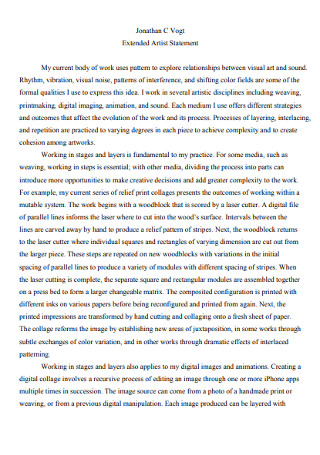
Sample Extended Artist Statement
-

Painting Artist Statement
-

Sample Experiance Artist’s Statement
-

General Artist Statement
-

Artist Statement Flow Chart
-

Sample Artist Statement Resume
-

Simple Artist Statement
-

Studio Artist Statement
-

Sample Artist Statements in PDF
-

Sample Artist Statement Worksheet
-

Sample Artist Statement Application
-

Personal Logo Design Artist Statement
-

Senior Artist Statement
-

Sample Artist Statement of Originality
-

Drawing and Painting Artist’s Statement
-

Contributing Artist’s Statement
-

Sample Artist Project Statement
-

Standard Artist Statement
-

Sample Artist Bio Statements
-
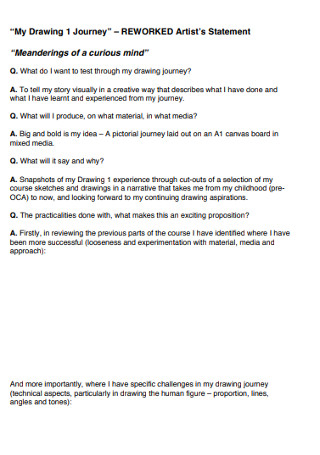
Artist’s Reworked Statement
-
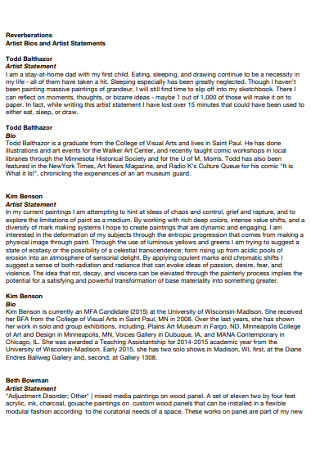
Artist Bios and Artist Statements
-

Artist Proposal Statement
-
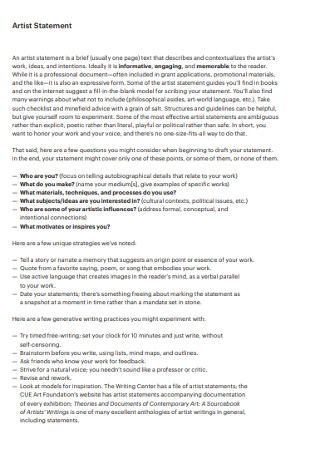
Formal Artist Statement
-

Visual Artist Statement
-

Visul Multi Model Artist Statement
-

Artist Statement Workshop in DOC
What Is an Artist Statement?
An artist statement is defined as a significant link between their body of work and the audience. It is a multi-purpose document that aims to provide viewers with a greater understanding of the artist’s creation, first and foremost. The second purpose of an artist statement is to reveal how conscious the artist is in regard to the themes and interpretations of his or her own work. Basically, it can function as a marketing letter of sorts. Writing artist statements is a relatively new activity that began in the 1990’s. Parts of it can resemble—and likely even derives partially—from the art manifesto. It is a requirement by some in order to apply for art schools, certain art-based jobs, or other kinds of institutional support.
Where there is art, you can also expect to find artist statements in this day and age. According to Statista, the United States has a 40% share of the global auction market. From the same source, public art auctions have amassed a total of $11.8 billion from 2010 to 2018 in the US alone. In terms of purchasing channels, social media has been steadily changing the game as well. Forbes reports that 22% of art buyers find and buy items through various social media platforms. This edges out purchases through museums and galleries, which attract only 20% and 15.9%, respectively. Considering how many still go out of their way to patronize the arts, not only are proper sales strategies needed, but the knowledge of art statements is practically a requirement for any aspiring artist as well.

The Types of an Artist Statement
There are at least four types of artist statements that you can choose to write at any given time. Each one has its own specific use or purpose and must be selected carefully. Take a look at the list below to get to know each type just a little bit better.
How to Write an Artist Statement
Now that you have been made aware of the different types of artist statements, the next part is to learn how to make one for yourself. The following instructions are guaranteed to make the experience easier and the output much higher in terms of quality. Take it one step at a time until you finish creating an artist statement for your own purposes.
Step 1: Consider Your Goals for Writing the Statement
An important prerequisite to writing an artist statement would have to be the knowledge of your own goals. Having this firmly in mind can help you organize your thoughts in the first place. You can start by envisioning what an overview of your body of work would look like. Depending on what your goals are, you can even consider featuring multiple projects or stick to a single one. Tailor the foundation of your artist statement around this before proceeding to the next step. Just like other scenarios, it helps if you make use of SMART goal setting.
Step 2: Consider Your Audience and Influences
After your goals, the next important consideration would be your audience. Get to the bottom of this by asking yourself who they are. Although art does not have to revolve entirely around the people consuming it, knowing your audience can help you write your artist statement when you find yourself stumped or at a loss for words. Following that, another thing that can help you would be to determine your artistic influences. Discovering or acknowledging them can help you describe your style and why you chose to pursue certain projects. A mixture of influences and the audience makes it easier to breakdown the explanation of your work in general.
Step 3: Choose the Right Program or Method for Writing
For the actual writing part of the process, it is recommended that you choose a method that you are most comfortable with. Many will decide to eventually print out their artist statements so it stands to reason that programs like MS Word, WPS Office, Google Docs, and others will come in handy. Fortunately, the many features among them and all are fairly easy to use. It is also worth exploring the idea of writing the artist’s statement in longhand. Some may even treat it as a mini-projector another demonstration of sorts, particularly those who have an interest in calligraphy.
Step 4: Write the Details of Your Ideas Accordingly
Now that you have prepared everything necessary for your artist statement, the next part entails the conversion of your thoughts into actual words, sentences, and paragraphs. Depending on what you are going for, your statement may even be as short as one or two paragraphs only. What is important for this step is how you write it and what you decide to include. Writing in a non-compelling manner would not do and neither would be slipping into abstractions. You need to organize your actual statement into a work that is not only engaging but also specific to boot. The dos and don’ts detailed below are sure to be quite helpful.
Step 5: Check for Any Errors
By this point, you would have finished the first of a few drafts. Maybe you may have even done more than that. Before you print out your artist statement, it pays to proofread it. Even after multiple drafts, you might still come across certain mistakes that will bring the quality of your statement down. If you are not sure of the results when checking it on your own, you can also opt to take a look at your work with the use of a proofreading program. Take your time with this step and ensure you are completely satisfied with the results before printing your artist statement out.
The Dos and Don’ts of an Artist Statement
Even with the steps dictated above, there are more things to keep in mind when attempting to create your own artist statement. After all, this is an important document that requires as much knowledge and skill as you can bring to the table. With that said, you may look through the detailed list of dos and don’ts below. Each one is guaranteed to help you take your writing game to the next level while making sure you successfully avoid the common pitfalls of this endeavor.
Dos
Do get to the point.
An artist’s statement is not meant to drag on and on endlessly. It is important that you get your point across in a manner that is as direct as possible. Leave behind anything that does not strengthen its quality or is unhelpful to the description of your work. Directness will not only make your statement that much better, but it will also be more appealing to the readers. Remember that few people are interested in reading a wall of text.
Do use active voice.
This is common advice for writers who aim to better engage with their readers. The use of action ensures that the text is far more concise and effective. It also helps in preventing or at least reducing, grammatical errors that come with the use of passive voice. Since the goal is to describe your artwork through this statement, you need to make sure that what you are writing is as engaging as possible.
Do be clear and specific.
One of the worst mistakes an artist can make with their statements is writing its contents in a vague or generalized manner. Be sure to take note that you are not describing anything other than what you have come up with. Therefore, it works to your benefit if you write the description in a manner that is as clear and specific as possible. Doing so will also help you better connect with your audience since they can get a more accurate perspective of what your work is trying to portray.
Do draw your reader into your work.
This is what sums up the purpose of your statement’s existence. Write for your audience and you do not need to fear the possibility of failure. If you do not or cannot draw your statement’s readers into your work, then you basically have nothing. To succeed in the endeavor, talk up the main selling points of your artwork. Describe what it is trying to invoke as well as what you aim to communicate through its visuals. With understanding comes a deep and genuine connection that any artist would crave.
Do proofread more than once.
Perfection is not something one can readily achieve in one go. The standard for many artist statements is quite high and the likeliness of turning off your audience is just as much. Proofreading is a necessity when it comes to any kind of writing endeavor. It may help to look over your work more than once. The preferable method for doing this would be to take some time away from the statement once it is finished. Then go back to it once your perspective of it is fresh again. Using proofreading programs is also recommended.
Do create various versions
In the aforementioned ‘how-to’ steps provided above, step one outlined the importance of knowing your goals for writing an artist statement. It does beg the question of what to do in the event you have more than a single goal. For such a scenario, the tip of creating multiple artist statements certainly comes well-recommended. The contents may be largely the same, but the way they are written are going to differ depending on what you want. One statement, for example, will be longer and more comprehensive, while another statement may feature almost the same thing, only shorter and more condensed.
Don’ts
Do not generalize.
Generalizing your statement is the way to go if you want to come up with something that is only acceptable at best. For most artists, acceptable is not enough. In order to draw people in and connect with them in a way that they want to purchase your artwork, the statement intended for its description must be written in a clear and specific manner.
Do not make use of jargon.
Even if your intended audience is a small and exclusive one, the rule of the thumb dictates that jargon should not be used for your artist statement. A less is more approach applies here in the sense that you can’t expect everybody to understand every bit of jargon you may want to include. Therefore, stick to the use of language that all can potentially understand. Make use of less or no jargon at all in order to achieve the best results.
Do not include biographical references.
Unless you are busy writing your bio, then it is recommended that you steer clear of any biographical references in your statement. You may be the creator of the artwork, but the statement is not about you. It is about the artwork, so stick to describing the artwork only. There is a time and place for everything and that definitely includes any biographical tidbits.
Do not include unnecessary content.
Write about a singular or individual work of art and nothing more. It is not recommended that you write about another creation in a statement meant for a specific project. One should also take care when it comes to the included content for anything that does not even have anything to do with art at all. Unnecessary information will only pad the artist’s statement in the most unhelpful of ways.
Do not come across as lacking in confidence.
It is a well-known fact that people are attracted to confidence. Those who write artist statements with the intention of connecting with their audience in a deeper and more meaningful way would do well to remember that. If you come off seeming like you lack confidence in your statement, then that will create consequences that you may not like. Another well-known fact is that perception is a reality and your presentation will play a big role in creating that perception. Write confidently and your audience will see you as such, providing your work with the attention that it richly deserves.
Do not use phrases like ‘I hope…’ or ‘I am trying to…’
To reiterate the previous tip, people are attracted to confidence and will perceive you as such when avoiding weak-sounding phrases. For this trip, there are specific phrases that you should avoid. Some of the more common examples are ‘I hope…’ and ‘I am trying to…’ since neither are indicative of your confidence. Instead, use phrases that are far more active-sounding and will inspire admiration among your artist statement’s readers.
There you have it. An artist’s statement is not just any document that artists can come up with. It is a nuanced item that should be planned out carefully and executed with precision. Those who need help even with the general instructions provided may look into online resources like templates. Just like poster templates, memo templates, and others, it is imperative to fully edit your artist statement template so that it fits your needs for it perfectly before printing it out.
